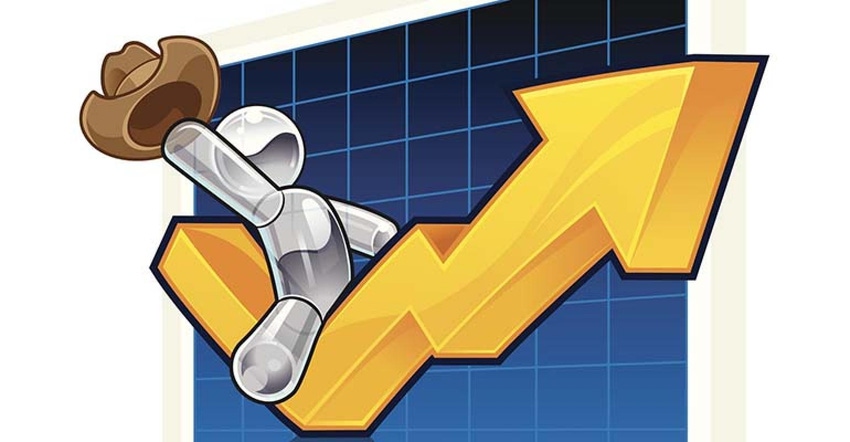February 24, 2023

“Boom!” That is what the local sports broadcaster yells when one of the players from our local high school teams drains a three-pointer. Some teams even have a 3-point salute when one of their teammates makes a three. Some cattle auctions hit their own “boomer” this week, with three -weight steers.
I remember back in 2014 the price of feeders was going up every week. I recall standing in the top row at one sale when I saw $3 steers for the first time. They weighed just over 300-pounds and even though we had not seen $3 calves yet they blew right past that and the gavel dropped at $3.33. $1,000 for a three weight. I recall telling my buddy that we now knew where all the gamblers were sitting.
A few minutes later they sold some steers that weighed around 525-pounds for $2.89. Those $1,500 five weights changed my mind about the three weights being over-valued. I knew my cost of gain and I knew I could easily make those three weights weigh five hundred for much less than $500.
That is what understanding your costs and having the market literacy to be able to interpret that into price relationships between weights of cattle can do for a person. The relationship between those two weights got the absolute price monkey off my back. $3.33 went from being to much for a little steer to a great buy very quickly in my mind.
When we saw three weight steers hit $3 this week, I remembered that experience from years ago and waited to see what other cattle brought before making a judgment on the person that bought the $3 calves. Sure enough there were some six weight steers that were over-valued to the three weights.
War and price history
Listening to ball games on the radio this week I happened to catch the news, and they were reminding us that it was one year ago that Russia invaded Ukraine. That reminded me that I had made a note about that in the market data that I keep for this blog and my marketing schools.
If we compare today’s prices to the prices early in the week before the invasion cattle under 500-pounds are up 15%, and cattle that weighed 600 to 900-pounds are up 18% (I am dropping the decimal). After the invasion cattle that weighed 500-pounds and under are up 7% and cattle 600-pounds to 900-pounds are up 15%. (these were steer prices)
The invasion affected on our markets. If you look at the prices paid on Monday that week last year to the prices paid on Wednesday it had a huge effect. The reason I investigate the past is that is where the data, or teaching tools, are. This illustrates that not all weights move value at the same rate.
People sometimes don’t like the idea of selling when the market is up and buying back in the same market. In their old paradigm you don’t buy when the market is high. High or low doesn’t matter, it’s the relationship between the sell and the buy.
If we look back at 2014 again and the lessons learned, the people with the idea of selling in the “high” market and not buying back until it dropped got run over. The market never dropped and when they finally decided to buy back in, they lost their buying power. They couldn’t sell and buy back on a head-for-head basis. The same amount of dollars couldn’t buy as many cattle. Greed will bite you back hard every time.
Markets and input costs
After the invasion prices of things started rising. Food and fuel prices rose much more than the price of cattle did. Going into the spring months some of our inputs were up as much as 35%. They remain higher than they were prior to the invasion even though they settled a bit since.
Here are some numbers I got from an article written by Michael Snyder. All the prices are up: Fuel oil 28%, electricity 12%, groceries 11%, milk 11%, eggs 70%, bread 15%, potatoes 12%, baby food 10%.
Then back to the market numbers I keep, our local corn bid is up 11% and the hay market is up 47%. (I am not saying the Russians are behind the increased price of hay, I am sure there is another factor).
Last year when inputs went up much faster and further than cattle the Value of Gain (VOG) got squashed, making it difficult to do trades. It was still possible but those trades had smaller margins.
You may be wondering how I can say the absolute price doesn’t matter when the prices of all the other things have gone up. Relationships are what matters because that is where the margin is. Here’s the thing, now that the price of cattle is up some it is making it easier to capture some margins. The reason being is the Return on the Gain (ROG), or the ratio of dollars to pounds on a trade, is higher.
The ROG is also getting help from the higher input costs. The market has intrinsically adjusted for these higher input costs, by widening the slides between weights. Here’s that recurring theme: the market has a way of helping us.
Funny things happen in this world and fear or greed kicks in and the markets overreact. If you are one of those kinds of people, the market will most certainly serve your head to you. If you can remain calm and have the market literacy to interpret what the signals are the market will reward you.
View from the cattle market
Since I’m writing about market moves this week there were two other big shifts. Feeder bulls were only discounted up to $15 and unweaned cattle were up to $35 (not a typo) back. 35 back on a bawling five weight is $175 per head. The worst VOG is between 5 and 600-pounds right now. Thing is the $175 monetary gain for weaning more than makes up for it. Some people might try to tell us that monetary gain and VOG are the same thing. This clearly illustrates they are not. Also, the industry has a slang term for monetary gain. If we bought these bawlers and weaned them and put some weight on them, we would devalue our feed by feeding it to them. The VOG is higher than the COG. But the monetary gain is so great we would still be in the black.
If we bought some heavily discounted bawling flyweights, the VOG is much higher than the COG coupled with the monetary gain and we have a boomer of a value capture (three figures).
The VOG has the trough effect right now. It is high on flyweight calves, get squished below COG on six weights, then it rises above COG on cattle up to nine hundred. Some places nine weights still have a high VOG and others there is a price cliff. Know the market you are selling into.
Fats are up 13% from a year ago. Thing is in dealing with today they are under-valued to feeder steers and over-valued to feeder heifers.
The opinions of Doug Ferguson are not necessarily those of beefmagazine.com or Farm Progress.
About the Author(s)
You May Also Like






